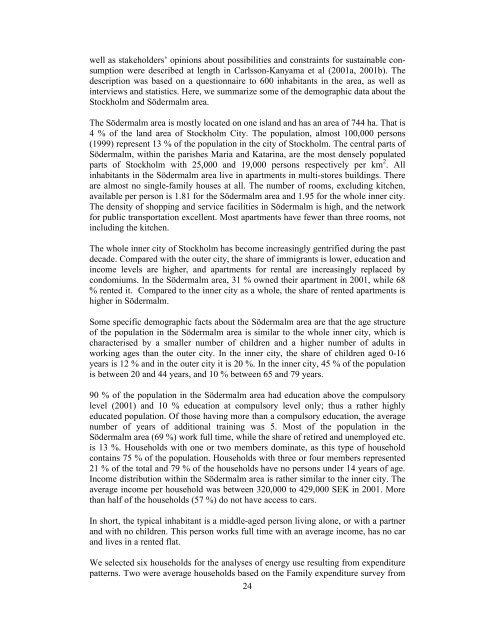Household Metabolism in the Five Cities.
Household Metabolism in the Five Cities.
Household Metabolism in the Five Cities.
Create successful ePaper yourself
Turn your PDF publications into a flip-book with our unique Google optimized e-Paper software.
well as stakeholders’ op<strong>in</strong>ions about possibilities and constra<strong>in</strong>ts for susta<strong>in</strong>able consumption<br />
were described at length <strong>in</strong> Carlsson-Kanyama et al (2001a, 2001b). The<br />
description was based on a questionnaire to 600 <strong>in</strong>habitants <strong>in</strong> <strong>the</strong> area, as well as<br />
<strong>in</strong>terviews and statistics. Here, we summarize some of <strong>the</strong> demographic data about <strong>the</strong><br />
Stockholm and Södermalm area.<br />
The Södermalm area is mostly located on one island and has an area of 744 ha. That is<br />
4 % of <strong>the</strong> land area of Stockholm City. The population, almost 100,000 persons<br />
(1999) represent 13 % of <strong>the</strong> population <strong>in</strong> <strong>the</strong> city of Stockholm. The central parts of<br />
Södermalm, with<strong>in</strong> <strong>the</strong> parishes Maria and Katar<strong>in</strong>a, are <strong>the</strong> most densely populated<br />
parts of Stockholm with 25,000 and 19,000 persons respectively per km 2 . All<br />
<strong>in</strong>habitants <strong>in</strong> <strong>the</strong> Södermalm area live <strong>in</strong> apartments <strong>in</strong> multi-stores build<strong>in</strong>gs. There<br />
are almost no s<strong>in</strong>gle-family houses at all. The number of rooms, exclud<strong>in</strong>g kitchen,<br />
available per person is 1.81 for <strong>the</strong> Södermalm area and 1.95 for <strong>the</strong> whole <strong>in</strong>ner city.<br />
The density of shopp<strong>in</strong>g and service facilities <strong>in</strong> Södermalm is high, and <strong>the</strong> network<br />
for public transportation excellent. Most apartments have fewer than three rooms, not<br />
<strong>in</strong>clud<strong>in</strong>g <strong>the</strong> kitchen.<br />
The whole <strong>in</strong>ner city of Stockholm has become <strong>in</strong>creas<strong>in</strong>gly gentrified dur<strong>in</strong>g <strong>the</strong> past<br />
decade. Compared with <strong>the</strong> outer city, <strong>the</strong> share of immigrants is lower, education and<br />
<strong>in</strong>come levels are higher, and apartments for rental are <strong>in</strong>creas<strong>in</strong>gly replaced by<br />
condomiums. In <strong>the</strong> Södermalm area, 31 % owned <strong>the</strong>ir apartment <strong>in</strong> 2001, while 68<br />
% rented it. Compared to <strong>the</strong> <strong>in</strong>ner city as a whole, <strong>the</strong> share of rented apartments is<br />
higher <strong>in</strong> Södermalm.<br />
Some specific demographic facts about <strong>the</strong> Södermalm area are that <strong>the</strong> age structure<br />
of <strong>the</strong> population <strong>in</strong> <strong>the</strong> Södermalm area is similar to <strong>the</strong> whole <strong>in</strong>ner city, which is<br />
characterised by a smaller number of children and a higher number of adults <strong>in</strong><br />
work<strong>in</strong>g ages than <strong>the</strong> outer city. In <strong>the</strong> <strong>in</strong>ner city, <strong>the</strong> share of children aged 0-16<br />
years is 12 % and <strong>in</strong> <strong>the</strong> outer city it is 20 %. In <strong>the</strong> <strong>in</strong>ner city, 45 % of <strong>the</strong> population<br />
is between 20 and 44 years, and 10 % between 65 and 79 years.<br />
90 % of <strong>the</strong> population <strong>in</strong> <strong>the</strong> Södermalm area had education above <strong>the</strong> compulsory<br />
level (2001) and 10 % education at compulsory level only; thus a ra<strong>the</strong>r highly<br />
educated population. Of those hav<strong>in</strong>g more than a compulsory education, <strong>the</strong> average<br />
number of years of additional tra<strong>in</strong><strong>in</strong>g was 5. Most of <strong>the</strong> population <strong>in</strong> <strong>the</strong><br />
Södermalm area (69 %) work full time, while <strong>the</strong> share of retired and unemployed etc.<br />
is 13 %. <strong>Household</strong>s with one or two members dom<strong>in</strong>ate, as this type of household<br />
conta<strong>in</strong>s 75 % of <strong>the</strong> population. <strong>Household</strong>s with three or four members represented<br />
21 % of <strong>the</strong> total and 79 % of <strong>the</strong> households have no persons under 14 years of age.<br />
Income distribution with<strong>in</strong> <strong>the</strong> Södermalm area is ra<strong>the</strong>r similar to <strong>the</strong> <strong>in</strong>ner city. The<br />
average <strong>in</strong>come per household was between 320,000 to 429,000 SEK <strong>in</strong> 2001. More<br />
than half of <strong>the</strong> households (57 %) do not have access to cars.<br />
In short, <strong>the</strong> typical <strong>in</strong>habitant is a middle-aged person liv<strong>in</strong>g alone, or with a partner<br />
and with no children. This person works full time with an average <strong>in</strong>come, has no car<br />
and lives <strong>in</strong> a rented flat.<br />
We selected six households for <strong>the</strong> analyses of energy use result<strong>in</strong>g from expenditure<br />
patterns. Two were average households based on <strong>the</strong> Family expenditure survey from<br />
24
















